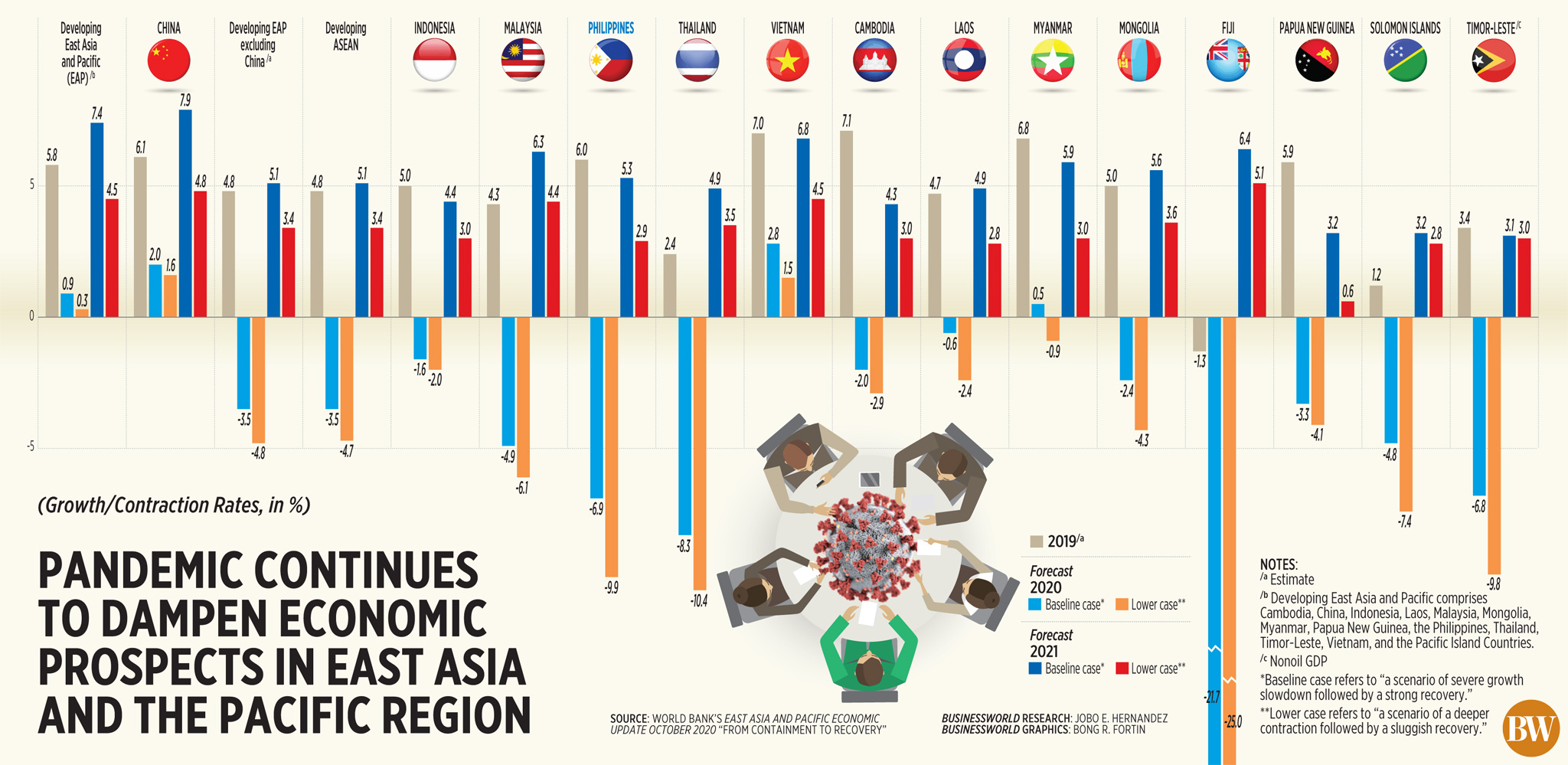
By Beatrice M. Laforga, Reporter
THE Philippines faces the prospect of an “uneven” and “volatile” economic recovery as it struggles to control the coronavirus disease 2019 (COVID-19) pandemic, the World Bank (WB) said after it slashed the country’s gross domestic product (GDP) forecast again this year.
In the October 2020 Economic Update for East Asia and the Pacific released on Tuesday, the multilateral bank said it now expects the Philippine’s GDP to shrink by 6.9% under a baseline scenario and a deeper 9.9% contraction under the low case scenario.
“The economy is projected to contract by 6.9% in 2020 owing in part to a reversal to tougher COVID-19 quarantine measures in August. Private consumption is expected to shrink in the second half of 2020 due to income losses, poor consumer confidence, and slow recovery in economic activities,” the World Bank said.
The Philippines was placed under a strict lockdown between mid-March to May. Quarantine rules have been slowly eased since then but restrictions were tightened in Metro Manila for two weeks in August as infections surged.
The latest outlook is significantly lower than the -1.9% baseline estimate penciled in June, and the government’s -4.5 to -6.6% GDP forecast.
The baseline projection assumes a “severe growth slowdown followed by a strong recovery,” while the low case scenario refers to a “deeper contraction followed by a sluggish recovery.”
The Philippines is expected to post the second-deepest slump among Association of Southeast Asian Nations (ASEAN) countries this year, after the -8.3% baseline projection and -10.4% low case projection for Thailand.
The ASEAN region’s economy is expected to contract by 3.5%, with only Vietnam and Myanmar seeing growth under the baseline scenario.
SLOW RECOVERY
The recovery of the Philippines and Indonesia appears uncertain since they “have not so far succeeded in controlling the pandemic,” the World Bank said.
The Philippines’ Health department reported 2,025 new COVID-19 cases on Tuesday, bringing the total to 309,303. This is the highest in Southeast Asia, followed by Indonesia with 278,722 cases.
“The return to pre-COVID-19 GDP level in the Philippines is around (towards the) end of 2021 based on our projections and the pace is slower in the Philippines than in Indonesia because the Philippines is much more connected to the world than Indonesia which is a very domestic driven, closed economy relative to the Philippines. Also in the last six months, the Philippines has been in a stricter lockdown than Indonesia,” World Bank Senior Economist Rong Qian said in an online press briefing Tuesday.
For next year, the World Bank cut its growth forecast for the Philippines to 5.3% under the baseline scenario (from 6.2% previously) and 2.9% under the low case situation. It also sees the Philippines growing by 5.6% in 2022.
Among eight developing ASEAN countries, the 2021 outlook for the Philippines is the fourth fastest behind Myanmar’s 5.9%, Malaysia’s 6.3% and Vietnam’s 6.8%.
The World Bank noted the Philippine economy’s rebound next year would be partly driven by the base effects coming from a weak print in 2020. However, the scheduled national elections in May 2022 could give a boost to the economy for the second half of 2021 through 2022.
“Our assumption is that we will continue this gradual reopening of the economy and that the COVID-19 is under (control or) at least we don’t see another spike that would (result in) a reversal of a strict lockdown in the first two weeks of August,” Ms. Qian said.
The baseline projection for 2021 also assumes businesses and households would regain confidence while the state continues to implement its infrastructure program.
Ms. Qian added the country’s recovery also depends on how quickly the global economy will bounce back. The World Bank estimates the developing ASEAN region growing by 5.1% next year.
“The downside scenario is the risk of reversal to a strict lockdown and a slower recovery or a deeper recession of the global economy,” she added.
POVERTY TO WORSEN
The World Bank said the ongoing crisis will create a class of “new poor” or people who have fallen below the poverty threshold unexpectedly because of the COVID-19 pandemic.
It estimated the number of poor people, or those living below $5.50 per day, in the East Asia and the Pacific region could rise by up to 38 million this year, of which 33 million should have escaped poverty under normal circumstances while five million will slide again to poverty.
Poverty in the Philippines is expected to climb to 22.4% this year from the estimated 20.5% rate last year based on the lower middle income poverty rate of $3.20 per day. This is also higher than the previous forecast of a 21.5% poverty incidence.
“In the case of the Philippines, this will translate a little bit more than two million people (pushed back to poverty),” Ms. Qian said.
This is higher than the bank’s estimate in June that 1.2 million Filipinos will slip into poverty.
She said they do not expect the poverty rate to go back to pre-pandemic levels by next year but this could gradually decline to 21.4%, and further down to 20.4% by 2022.
Based on the upper middle-income poverty level of a $5.50 spending per day, the poverty rate is seen increasing to 52.1% by year’s end from 50.4% in 2019, before it slowly declines to 51.3% next year and 50.4% in 2022.

